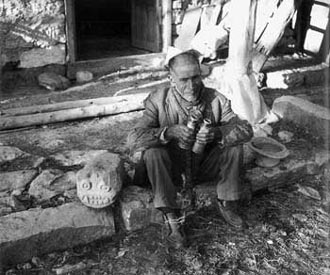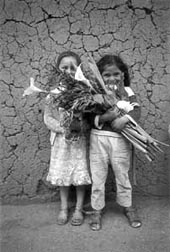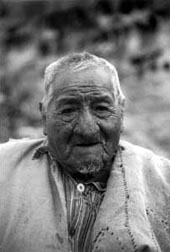![[MetroActive Books]](/gifs/books468.gif)
[ Books Index | Metro Santa Cruz | MetroActive Central | Archives ]
Andean Adventure
 From 'Warriors of the Clouds' Walk in the Clouds: Keith Muscutt weaves the history and culture of the Peruvian Chachapoyas in his new book, 'Warriors of the Clouds.' UCSC assistant dean of the arts by day, Andean archaeologist by night (summers, actually), Keith Muscutt puts a visual spin on his many expeditions with his handsome new book By Christina Waters THOUGH HE USED TO bristle at being compared to Indiana Jones, Santa Cruz archaeological adventurer Keith Muscutt seems to have calmed down about it--especially since the recent publication of his book, Warriors of the Clouds: A Lost Civilization in the Upper Amazon of Peru, by the University of New Mexico Press ($29.95 soft cover). Liberally laced with Muscutt's breathtaking photographs and his accessible text, the book represents a milestone in more than 20 years of treks through the misty highlands of northeastern Peru. Originally provoked by 19th-century maps of an off-the-beaten-track region, the expeditions represent a personal passion for antique cultures and their contemporary ancestors. "I'm not interested in going to places that have already been done," Muscutt admits when asked why he chose to focus on the Chachapoyas, a group invariably bypassed for the more glamorous Inka, who conquered the Chachapoyas in the 15th century only to be subdued themselves by conquistadors fewer than a hundred years later. It was the mighty rock citadel of Kuelap, a lost Chachapoyas stronghold emerging tentatively from the thick jungle underbrush of the steep Andean cordilleras, that really got--and held--Muscutt's attention during his first journey. After that, each summer contained new discoveries--of cliff tombs, serpentine rock walls and elaborate façades--rising out of the upper Amazonian bromeliad groves and hillsides terraced with fields of coca, tobacco and potatoes. The annual odysseys ("entirely self-funded--proudly unsupported") allowed Muscutt the freedom to be a self-described maverick. They also inspired his deepening affection for present-day Chachapoyas--whose name means "cloud warriors" and whose ancestors flourished in the 13,000-foot highlands. "In order to experience the archaeology I had to get involved with the local people--as guides, informants, muleteers," Muscutt explains, "and over the years a true cultural exchange has taken place." Currently acting as godfather to four children in and around the central village of Chuquibamba, Muscutt believes that he has "helped bring information back to the contemporary Chachapoya about the value of their culture and history." Over the years, his expeditions have come equipped with antibiotics and physicians who helped tend to the needs of villagers--prompting him to create the Fundación Benéfica para los Niños de Chuquibamba. After 20 years of high-altitude exploration in a region so remote that it takes 10 days to get to base camp--and another 10 days to get out--Muscutt has tales to tell. Poisonous snakes, blood-sucking vampire bats, emergency surgery, broken equipment, barroom brawls, frostbite, and coca-induced altered states are all part of his autobiography. "The real dangers aren't snakes or terrorists," he grins, "but transit accidents, like bus wrecks and a few potentially life-threatening mule accidents." Lucera, Muscutt's trusty mule, has packed him across vertiginous mountain bridges and sheer cliffs for 16 years. "But mules get tired, and trails and bridges collapse under their weight. This last year Lucera sank in a swamp and rolled over on top of me." Muscutt confesses that he didn't have the colorful fiasco photographed because it looked "too staged." "The real work of the expeditions is the nerve-racking amount of pre-planning," he explains. "There's incredible preparation for going so far into the jungle. And then you come back and you've got 50 rolls of film to go through." Muscutt's life has become interwoven with those of his longtime Indian friends in the region, many of whom are in their 30s before ever setting foot outside their village. "I'll go back there as long as I'm physically able, to see my Peruvian family and to see what lies over the next mountain," he says. Scanning the jungle-covered cliffs last summer for signs of man-made features, Muscutt shot footage that recently revealed yet another citadel, the twin of his huge rediscovery of the city of Vira Vira. "It's true," he confesses, "this land awes me. I know that I and others have only scratched the surface of this vast region. So much of the eastern side of the central cordillera is unexplored territory--there must be 10 times the number of sites just waiting to be uncovered." He loves to joke that "you'd have to be a fool not to discover ruins in this place." Muscutt keeps going back partly in response to what he believes to be the universal trait of intellectual curiosity. "I was one of those kids who incessantly dug up things in the backyard. ... [It's also] the need to be outdoors, to challenge my mind and body. "I think I can claim to have put the Chachapoyas on the map," he admits. "The ancient ones deserved to have a book about them. And personally, I feel fulfilled by the opportunity to explore. The region is incredibly exotic. "All the stars, the infinite vistas of the mountains," he sighs with satisfaction. "If I can do it, anyone who's determined enough can do it."
Living in the Clouds: Two Chuquibambinas carry flowers to church; a campesino's face expresses some of the melancholy of the region's history. Ahead in the Clouds
EVERYONE who grew up dreaming over the pages of National Geographic or digging in the backyard hoping to discover some remnant of a long-lost culture will find breathtaking food for thought in Keith Muscutt's newly released Warriors of the Clouds. Illustrated and often illuminated by the author's evocative photographs, Warriors plunges the readers into the highlands of northeastern Peru and takes them along on a series of expeditions that Muscutt led over the course of the past two decades. Fueled by his interest in the relatively unexplored territory of the Chachapoya civilization, which flourished a thousand years ago, Muscutt began trekking into the rugged landscape, whose ancient agricultural terraces, jungles and shimmering cliffs are richly documented by his photography. While the photographs themselves form a visual document of these expeditions on which Muscutt surveyed and recorded the ruins of proud fortresses and serpentine hilltop architecture, the book is by no means a coffee-table ornament. The networks of stonework, hacked laboriously from the invading jungle by Muscutt and his team of Chachapoya guides, are revealed by his written narrative and analysis to occupy a unique place in the history of the region. The book eases the archaeological novice into the background of the Chachapoyas' relationship to their conquerors, the Inka, and explains enough about the present-day structure of the Peruvian highlands in terms of politics, geography and agriculture to stimulate appreciation for Muscutt's passion and persistence. As the photographs eloquently testify, this is a brutally beautiful landscape, one whose visual rewards are hard-won. Dense jungle and 13,000-foot altitudes stretched each one of his annual expeditions into endurance contests, during which the author found himself in a deepening relationship with the present-day Chachapoya, a warmhearted and dignified group with a tenuous relationship to both modern medicine and monetary wealth. Warriors of the Clouds details the false leads, backtracking and ultimate triumphs of detective work that led Muscutt face to face with a vast array of cliff tombs, vivid petroglyphs, mummies and millennia-old textile artifacts. Chapters interweave the living Chachapoya, most especially at Muscutt's base-camp village of Chuquibamba, with maps and photographs of ancient rock foundations that literally carpet the jungle floor and slopes of the region. Especially effective is the book's layout, in which full-bleed telephoto images of villages seemingly floating in the Andean clouds alternate with close-ups of geometric rock carvings rescued from voracious jungle vegetation. A sequence of clearheaded narrative decisions gives this book an accessibility rare in its all-too-overwrought field. Muscutt explains enough background to allow the reader to travel with him, and then he gets out of the way. The rugged grandeur of the land, its people and the presence of such an abundance of provocative ruins all conspire to make for top-notch adventure reportage.
Warriors of the Clouds is available at bookstores or through Muscatt's Web site. [ Santa Cruz | MetroActive Central | Archives ]
|
From the December 24-30, 1998 issue of Metro Santa Cruz.
Copyright © Metro Publishing Inc. Maintained by Boulevards New Media.

